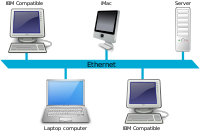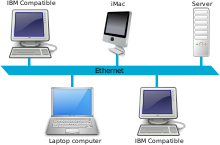Usor:Jondel/agenda/ethernet


- wireless
- wire filamentum
- pc
- lan
- commercially
- twisted pair torqus par
- packet
- PC?
Ethernet est familia technologiarum computatorum retium, technologiam latior omnibus in rete localis (LAN) praestante surgente aliis technologiis sicut ARCNET et Token Ring,et commercio inlatum in 1980 cuius normae regulaeque constitae in [IEEE] [[[802.3.]]]. In systema OSI, Ethernet operat in strato tabulato Data Link Layer. In practical terms it is the most used system of wire network for PCs. Est maxima usitata in filamento reti Computatro Privato(PC). ARCNET, Token Ring and other technology standards have been used in the past, but Ethernet over twisted pair cabling, and Wi-Fi are the two most common technologies currently used to build LANs.ARCNET, Token Ring et alia systema sunt adhibentae antequam sed, paene semper Ethernet in tortum par iugium /torqum geminum filamentum twisted pair cabling etiam appellatur 10 Base T.(inter alia), et Wi-Fi (pro rete sine filamento)sunt nuper duobos technologiae vulgatiore omnibus LAN creandum.are the two most common technologies currently used to build LANs.Creata est in societate Xerox PARC a Robert Metcalfe permoto a ALOHANet ut pars dissertationis magistratis (Anglice PHd) circa annis ab 1972 usque 1974. Ante mittere, data sunt divisa in scrinium/scrinio( 'packet')(fascicula ) vel 'frame' quod [[[algorismum]] CSMA/CD modulatur /frenatur. Quoti fascicula habet informationem destinationem et agnitionem. Velocitas data communicandum est 100 gigabits per secondum auctata ex in fascia amplitudo(Anglice bandwitdh) 10 megabits per secondum .origine 10 megabits per secondum. filamentum
Ethernet /ˈiːθərnɛt/ is a family of computer networking technologies for local area networks (LANs) commercially introduced in 1980. Standardized in IEEE 802.3, Ethernet has largely replaced competing wired LAN technologies. In the OSI reference system, Ethernet is at the Data Link layer.
Ethernet was developed at Xerox PARC between 1973 and 1974.[1][2] It was inspired by ALOHAnet, which Robert Metcalfe
queles sunt. Systems communicating over Ethernet divide a stream of data into individual packets called frames. Each frame contains source and destination addresses and error-checking data so that damaged data can be detected and re-transmitted.CDMA.48-bit MAC address . A node is either transmitting or receiving at any instant. The bandwidth is about 10 Mbit/s. Disk-Ethernet-Disk transfer rate with TCP/IP is typically 30 kilobyte per second.
The standards comprise several wiring and signaling variants of the OSI physical layer in use with Ethernet. The original 10BASE5 Ethernet used coaxial cable as a shared medium. Later the coaxial cables were replaced by twisted pair and fiber optic links in conjunction with hubs or switches. Data rates were periodically increased from the original 10 megabits per second, to 100 gigabits per second.
Since its commercial release, Ethernet has retained a good degree of compatibility. Features such as the 48-bit MAC address and Ethernet frame format have influenced other networking protocols.
Contents [hide] 1 History 2 Standardization 3 Evolution 3.1 Shared media 3.2 Repeaters and hubs 3.3 Bridging and switching 3.4 Advanced networking 4 Varieties of Ethernet 5 Ethernet frames 6 Autonegotiation 7 See also 8 Notes 9 References 10 Further reading 11 External links
[edit] History
Ethernet was developed at Xerox PARC between 1973 and 1974.[1][2] It was inspired by ALOHAnet, which Robert Metcalfe had studied as part of his PhD dissertation.[3] The idea was first documented in a memo that Metcalfe wrote on May 22, 1973.[1][4] In 1975, Xerox filed a patent application listing Metcalfe, David Boggs, Chuck Thacker and Butler Lampson as inventors.[5] In 1976, after the system was deployed at PARC, Metcalfe and Boggs published a seminal paper.[6][note 1]
http://dictionary.reference.com/browse/ethernet?s=t
Computing Dictionary
Ethernet definition networking A local area network first described by Metcalfe & Boggs of Xerox PARC in 1976. Specified by DEC, Intel and XEROX (DIX) as IEEE 802.3 and now recognised as the industry standard. Data is broken into packets and each one is transmitted using the CSMA/CD algorithm until it arrives at the destination without colliding with any other packet. The first contention slot after a transmission is reserved for an acknowledge packet. A node is either transmitting or receiving at any instant. The bandwidth is about 10 Mbit/s. Disk-Ethernet-Disk transfer rate with TCP/IP is typically 30 kilobyte per second. Version 2 specifies that collision detect of the transceiver must be activated during the inter-packet gap and that when transmission finishes, the differential transmit lines are driven to 0V (half step). It also specifies some network management functions such as reporting collisions, retries and deferrals. Ethernet cables are classified as "XbaseY", e.g. 10base5, where X is the data rate in Mbps, "base" means " baseband" (as opposed to radio frequency) and Y is the category of cabling. The original cable was 10base5 ("full spec"), others are 10base2 ("thinnet") and 10baseT ("twisted pair") which is now (1998) very common. 100baseT (" Fast Ethernet") is also increasingly common. Usenet newsgroup: news:comp.dcom.lans.ethernet. (http://wwwhost.ots.utexas.edu/ethernet/ethernet-home.html). (1997-04-16)
The Free On-line Dictionary of Computing, © Denis Howe 2010 http://foldoc.org
Cite This Source Word Dynamo Rating For EthernetPeople who can define Ethernet may know 25,133 words, as many as a 8th grader. How many words do you know?
Remove ads like these. Upgrade now! Quote Of The Day "The reward of a thing well done, is to have done it." -Ralph Waldo Emerson MOREPartners:WordBloglinesCitysearchThe Daily BeastAsk AnswersAsk KidsLife123SendoriThesaurus
